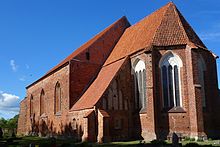Hall (Western Pomerania)
| coat of arms | Germany map | |
|---|---|---|

|
Coordinates: 54 ° 19 ′ N , 12 ° 30 ′ E |
|
| Basic data | ||
| State : | Mecklenburg-Western Pomerania | |
| County : | Western Pomerania-Ruegen | |
| Office : | Barth | |
| Height : | 5 m above sea level NHN | |
| Area : | 49.19 km 2 | |
| Residents: | 1430 (Dec. 31, 2019) | |
| Population density : | 29 inhabitants per km 2 | |
| Postal code : | 18317 | |
| Primaries : | 038223, 038227 (Bartelshagen II near Barth) | |
| License plate : | VR, GMN, NVP, RDG, RÜG | |
| Community key : | 13 0 73 077 | |
| Office administration address: | Tar passage 2 18356 Barth |
|
| Website : | ||
| Mayor : | Wolfgang Pierson ( CDU ) | |
| Location of the municipality of Saal in the district of Vorpommern-Rügen | ||
Saal is a municipality in the district of Vorpommern-Rügen in Mecklenburg-Vorpommern (Germany). It is administered by the Barth Office based in the city of the same name .
geography
Located between Ribnitz-Damgarten and Barth , near Saal the Saaler Bach flows into the Saaler Bodden , which forms part of the Darß-Zingster Bodden chain .
Community structure
The districts belong to Saal:
|
|
After the Thirty Years' War until 1815, the area belonged to Swedish Pomerania and then to the Prussian province of Pomerania .
The community was then part of the Franzburg-Barth district until 1952 and then belonged to the Ribnitz-Damgarten district in the Rostock district until 1994 . Saal has been part of the state of Mecklenburg-Western Pomerania since 1990.
On January 1, 2014, the municipality of Bartelshagen II b. Barth with its districts Bartelshagen II, Hermannshagen Heide, Hermannshof and Neuhof incorporated into Saal.
history
We find the first mention of Saal in a document from the city of Barth from 1255. At that time there was already an abandoned Slavic castle complex at the mouth of the Saaler Bach in today's Saaler Bodden . The castle complex is likely to be Stekeborg or Stekenborg . In all the times when the castle complex was managed, the bay still had free access to the Baltic Sea. The location, both hidden and provided with the possibility of monitoring the vast bodden area, was strategically valuable.
Around 1255 the population consisted of established Slavs , immigrant Westphalians and Danes . The first church already existed at that time, but was entirely made of wood and consecrated to the "Holy Cross".
In the 13th century, the Bailiwick "Sale" named after the place was one of the twelve bailiwicks of the Prince of Rügen . Saal was the seat of the bailiff and thus the administrative center, market place and court of the province, to which twelve other villages belonged. Later, Saal lost its importance and Barth and Damgarten took over this role. After 1326 it belonged to the Duchy of Pomerania .
politics
Municipal council and mayor
In the election of the municipal council on May 26, 2019 , the CDU received six seats (share of the vote 52.5%), Die Linke one seat (12.4%), the "WG Bauernverband und Rural Areas" two seats (22.2%) and the voting group "OST" one seat (12.9%). The turnout was 58.5%. Wolfgang Pierson (CDU) was elected mayor with 69.7% of the valid votes.
coat of arms
The coat of arms was approved by the Ministry of the Interior on August 15, 1995 and registered under the number 86 of the coat of arms of Mecklenburg-Western Pomerania.
Blazon : "In blue a boarded-up silver tower with a base that becomes stronger downwards, a tent roof and two black window openings, surrounded by a golden ear of wheat in front and a silver fish in the back."
The coat of arms was designed by Barther Wolfgang Sohn .
Attractions
→ See also the list of architectural monuments in Saal (Western Pomerania)
- Village church hall
- Twelve Apostles, cult site from the Middle and New Stone Ages
- Hessenburg Tower Hill
- Hessenburg manor house as crane museum and crane hotel; a 2-storey, 10-axis, renovated manor house with a central projectile .
Others
According to legend, the Vitalienbrüder under Klaus Störtebeker are said to have used the castle on the Bodden until 1391 and from there they brought a treasure under the current bell tower of the village church. In 1391 they were involved in a battle with the Danes on the Ribnitzer See, had to flee and never entered the floor of Saal again. So the treasure should still lie there.
Personalities
- Wilhelm Bruhn (1869–1951), German politician (DNVP) and publisher, MdR.
- Balthasar Anton Dunker (1746–1807), German landscape painter, caricaturist and writer
literature
- Andreas Ciesielski : Hall through the ages. Eine Chronik , Scheunenverlag, ISBN 3-938398-06-X
Web links
Individual evidence
- ↑ Statistisches Amt MV - population status of the districts, offices and municipalities 2019 (XLS file) (official population figures in the update of the 2011 census) ( help ).




